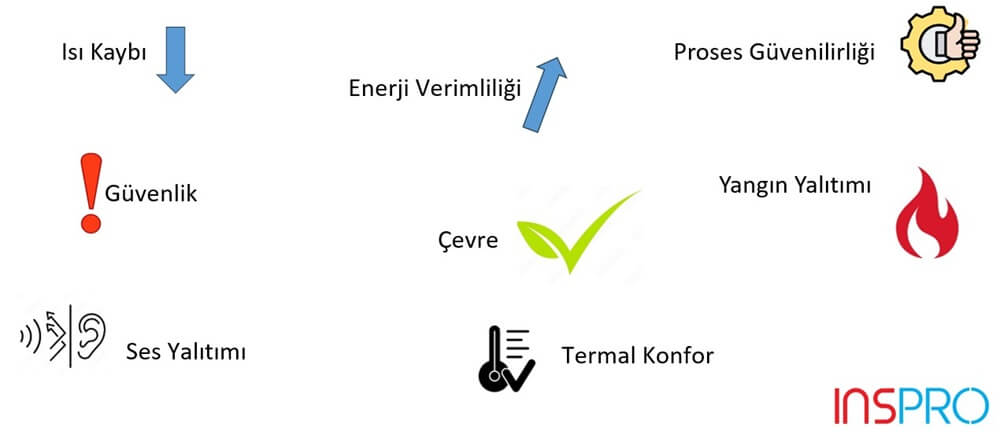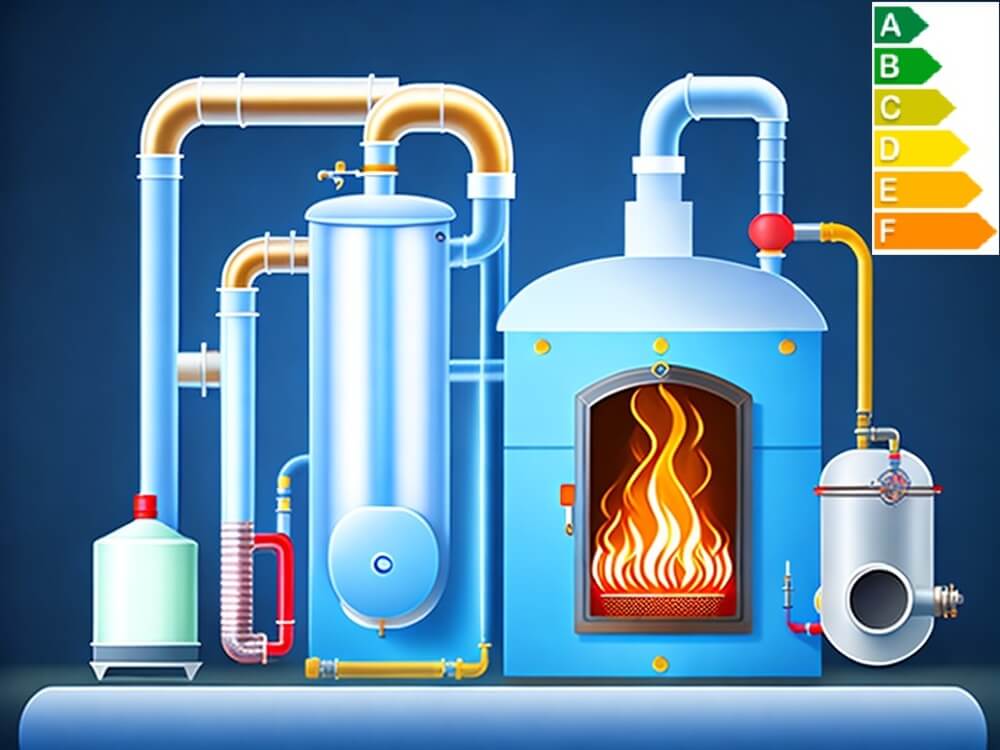Why is Insulation Necessary and Why Do We Neglect It?
Professionals in industrial facilities generally share a common understanding:
“Insulation is a crucial parameter for various reasons.”
However, the insulation system is often the easily overlooked first component of the entire facility, from the design stage to maintenance and improvement needs, consistently lagging behind the primary process requirements of the plant.
So, let’s first summarize the reasons for the need for insulation:
Reasons for Insulation:
First and foremost, it must be determined which of the following or which combinations justify the need for insulation:–
- Energy Savings
- Preservation of Process Reliability
- Personnel Protection
- Protection Against Freezing and Winter Conditions
- Fire Insulation
- Sound Insulation
- Environmental Awareness
As explained in the opening paragraph, the preservation of process stability is the primary reason for insulation in most industrial facilities. The subsequent priorities are usually personnel protection and prevention of freezing, both supporting the goal of process stability.
In conclusion, it is understood that insulation is almost always considered only as an auxiliary element for the main process of the facility, and other justifications are often neglected unless a mandatory process is required.
But why is that?
Now, let’s examine some reasons against insulation:
Low Standards and Non-Mandatory State:
When a new industrial facility is constructed, contractors tend to fulfill contract terms for all kinds of work, including insulation. As understood from the paragraph above, process reliability is the top priority even during the design and construction stages of an industrial facility. This priority will not change throughout the lifetime of the facility. Therefore, proper insulation is often neglected from the design/construction stage and continues through the operational stage. Companies also tend to use their own procedures, often prepared with outdated requirements that need updating at best, as there is no mandatory requirement for proper insulation.
However, there are continuously updated standards (such as CINI) to determine insulation specifications independently of questionable procedures. These standards include design and application specifications based on scientific facts and are often updated periodically.
For more information: https://insulant.pro/cini-international-standart-for-industrial-insulation/
Competence:
It is evident that industrial insulation is not a simple system that can be designed and maintained appropriately without the necessary qualifications. Partly for this reason, old procedures are not adequately updated.
However, this challenge can be overcome by hiring/appointing qualified personnel and/or obtaining services from an experienced company in the relevant process.
For more information: https://insulant.pro/services
Cost:
When there is an investment plan on the table, any asset owner naturally seeks the highest return on investment (ROI) possible. The key parameters are the construction, operation, and maintenance costs over a specific period. Again, process reliability becomes the top priority for any industrial facility, and the maintenance or improvement of construction or insulation systems becomes “extra” expenses that need to be minimized. However, of course, when considering an insulation system, the whole equation involves much more than just costs. Evaluating the value of money over the working life and lifespan of an insulation system involves a kind of multi-variable equation, often revealing surprising results that contradict traditional insulation practices.
For more information: https://insulant.pro/services
The payback period for insulation costs for an uninsulated high-temperature component (pipe, fitting, tank, equipment, etc.) on the table is sometimes less than a month. If we are doing insulation for improvement or repair, this period usually does not exceed one year.
Potential Risks of Isolating a Component
From the perspective of a process engineer, an insulation system has some potential risks. One of them is the observation of leaks in a connection element. For example, an insulated flange or valve becomes unobservable if it leaks under insulation, damaging the connection element and process reliability. However, these barriers can be overcome by using appropriate accessories integrated with the insulation system. https://insulant.pro/corrosion-under-insulation
Another risk, which is the most significant, is the phenomenon of Corrosion Under Insulation (CUI). CUI is a term used for various corrosion mechanisms but is usually caused by the presence of electrolytes such as rainwater or leaking liquids containing chlorine. https://insulant.pro/cini-international-standart-for-industrial-insulation/. When dealing with CUI risks, priorities should include long-term solutions and minimizing future failures. Of course, this struggle requires top management with sufficient budget and effort as long as the facility continues to operate. In conclusion, a well-designed insulation system contributes directly to the facility’s profit as more than just a specification or adherence to outdated procedures.
CONCLUSION
A correctly designed insulation system has many advantages, such as reducing costs, reducing environmental impacts, and preventing the entire process system from being overloaded. Additionally, we have summarized the disadvantages of an insulation system investment and rational solutions to them above.
In conclusion, insulation inspections using scientific methods will help facility management make the right decisions. A well-designed insulation system, which is more than just preparing a specification or adhering to old-fashioned procedures, can contribute directly to the facility’s profit.
Why is Insulation Necessary and Why Do We Neglect It?
Professionals in industrial facilities generally share a common understanding:
“Insulation is a crucial parameter for various reasons.”
However, the insulation system is often the easily overlooked first component of the entire facility, from the design stage to maintenance and improvement needs, consistently lagging behind the primary process requirements of the plant.

So, let’s first summarize the reasons for the need for insulation:
Reasons for Insulation:
First and foremost, it must be determined which of the following or which combinations justify the need for insulation:–
- Energy Savings
- Preservation of Process Reliability
- Personnel Protection
- Protection Against Freezing and Winter Conditions
- Fire Insulation
- Sound Insulation
- Environmental Awareness
As explained in the opening paragraph, the preservation of process stability is the primary reason for insulation in most industrial facilities. The subsequent priorities are usually personnel protection and prevention of freezing, both supporting the goal of process stability.
In conclusion, it is understood that insulation is almost always considered only as an auxiliary element for the main process of the facility, and other justifications are often neglected unless a mandatory process is required.
But why is that?
Now, let’s examine some reasons against insulation:
Low Standards and Lack of Obligation: No Longer an Excuse
In the design and construction phases of industrial facilities, insulation is often treated as a secondary concern. Since process reliability is the top priority, insulation systems are typically implemented with minimal requirements—if at all. This mindset often persists into the operational phase, where insulation is only addressed when explicitly required. However, this approach has fundamentally changed with the introduction of the EN 17956 standard, effective as of December 1, 2024, across all 34 CEN/CENELEC member countries, including Turkey. EN 17956 is a European standard that defines the energy performance of insulation systems used in industrial applications. It classifies insulation solutions into energy efficiency grades ranging from A (most efficient) to F (least efficient). This classification clearly indicates the potential of each solution to reduce energy consumption and CO₂ emissions. The scope of EN 17956 covers insulation systems applied to operational installations such as pipes, ducts, tanks, equipment, and embedded components operating within a temperature range of –30°C to +650°C. It does not apply to insulation used for personal protection (e.g., safe surface temperatures) or condensation prevention. Thanks to this standard, insulation systems now benefit from:
- Clear energy efficiency targets
- Measurable cost-saving potential
- Quantifiable environmental sustainability
- A reliable framework for benchmarking and compliance

In short, EN 17956 replaces outdated procedures with a scientifically grounded, up-to-date, and comparable framework. It reinforces the fact that insulation is no longer a dispensable add-on—it is a strategic system that must be managed with precision.
For more information:
https://insulant.pro/echnical-insulation-energy-efficieny-calculation/
Competence:
It is evident that industrial insulation is not a simple system that can be designed and maintained appropriately without the necessary qualifications. Partly for this reason, old procedures are not adequately updated.
However, this challenge can be overcome by hiring/appointing qualified personnel and/or obtaining services from an experienced company in the relevant process.
For more information: https://insulant.pro/services
Cost:
When there is an investment plan on the table, any asset owner naturally seeks the highest return on investment (ROI) possible. The key parameters are the construction, operation, and maintenance costs over a specific period. Again, process reliability becomes the top priority for any industrial facility, and the maintenance or improvement of construction or insulation systems becomes “extra” expenses that need to be minimized. However, of course, when considering an insulation system, the whole equation involves much more than just costs. Evaluating the value of money over the working life and lifespan of an insulation system involves a kind of multi-variable equation, often revealing surprising results that contradict traditional insulation practices.
For more information: https://insulant.pro/services
The payback period for insulation costs for an uninsulated high-temperature component (pipe, fitting, tank, equipment, etc.) on the table is sometimes less than a month. If we are doing insulation for improvement or repair, this period usually does not exceed one year.
Potential Risks of Isolating a Component
From the perspective of a process engineer, an insulation system has some potential risks. One of them is the observation of leaks in a connection element. For example, an insulated flange or valve becomes unobservable if it leaks under insulation, damaging the connection element and process reliability. However, these barriers can be overcome by using appropriate accessories integrated with the insulation system. https://insulant.pro/corrosion-under-insulation
Another risk, which is the most significant, is the phenomenon of Corrosion Under Insulation (CUI). CUI is a term used for various corrosion mechanisms but is usually caused by the presence of electrolytes such as rainwater or leaking liquids containing chlorine. https://insulant.pro/cini-international-standart-for-industrial-insulation/. When dealing with CUI risks, priorities should include long-term solutions and minimizing future failures. Of course, this struggle requires top management with sufficient budget and effort as long as the facility continues to operate. In conclusion, a well-designed insulation system contributes directly to the facility’s profit as more than just a specification or adherence to outdated procedures.
CONCLUSION
A correctly designed insulation system has many advantages, such as reducing costs, reducing environmental impacts, and preventing the entire process system from being overloaded. Additionally, we have summarized the disadvantages of an insulation system investment and rational solutions to them above.
In conclusion, insulation inspections using scientific methods will help facility management make the right decisions. A well-designed insulation system, which is more than just preparing a specification or adhering to old-fashioned procedures, can contribute directly to the facility’s profit.
